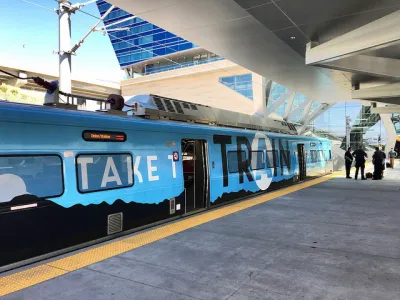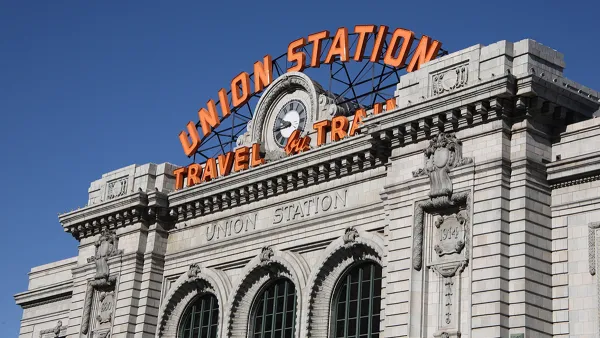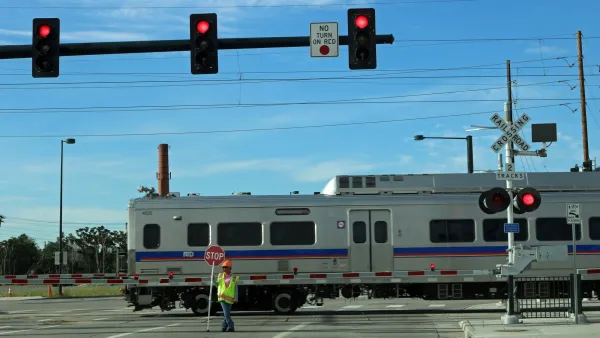Ridership on the electrified A Line, which opened to great fanfare on Earth Day, reached a weekday average of 16,910 as of June 5. The 23-mile line operates from Union Station to Denver International Airport. Not all is perfect though.

The University of Colorado A Line "enjoys an on-time performance average of 89 percent, said Dave Genova, Regional Transportation District’s general manager," writes Monte Whaley, Denver Post reporter covering transportation. "And overall ridership during its sixth week of operation — from May 30 to June 5 — hit a new weekday average of 16,910."
Genova admitted there were “things we did not see in testing. And I’m not satisfied with our performance as it is,” he said.
The record ridership makes the 23-mile line the 11th busiest commuter rail line in the U.S., just after the 83-mile UTA Frontrunner commuter line that opened in 2008, according to March 2016 data from the American Public Transportation Association via Wikipedia.
Ridership would appear to be influenced by passenger traffic at DIA, which surged in April.
However, some Regional Transportation District (RTD) board members are nonetheless concerned about operation problems which have surfaced, writes Whaley. For the second time since service began on April 22, lightning strikes halted service for about two hours on June 13.
Grade Crossings
While the A Line has some of the operating features of heavy rail, such as operating frequency, hours of operation, and level boarding, not all grade crossings are separated, and that can create problems when power is lost, such as during lightning strikes.
"RTD workers are still at 10 train crossings along the A-Line route to make sure gates are working properly, said RTD spokesman Nate Currey [on June 13].
More extensive problems at the crossings, which are also used by Union Pacific Railroad, particularly with the crossing gates, were detailed by Whaley and Denver Post staff writer John Aguilar last month.
Positive Train Control
"RTD board chair Tom Tobiassen said the new technology being used on the A-Line — including Positive Train Control (PTC) to prevent derailments or collisions — is a challenge to implement," wrote Whaley and Aguilar.
“We are the only transit agency that has Positive Train Control built into its system, everybody is watching what we do,” Tobiassen said [May 10]. “Everybody is going to learn a lot from this.”
Extra costs incurred at the grade crossings appear to be borne by Denver Transit Partners, the private partner in RTD's successful Eagle P3 Project, the nation's first full public-private partnership for transit.
Look for RTD's second commuter line, the 6-mile, Northwest B Line from Union Station to Westminster Station, to begin service on July 25, 2016.
Hat tip to Annie Dawid.
FULL STORY: Union Station-DIA train criticized by RTD board

Analysis: Cybertruck Fatality Rate Far Exceeds That of Ford Pinto
The Tesla Cybertruck was recalled seven times last year.

National Parks Layoffs Will Cause Communities to Lose Billions
Thousands of essential park workers were laid off this week, just before the busy spring break season.

Retro-silient?: America’s First “Eco-burb,” The Woodlands Turns 50
A master-planned community north of Houston offers lessons on green infrastructure and resilient design, but falls short of its founder’s lofty affordability and walkability goals.

Test News Post 1
This is a summary

Analysis: Cybertruck Fatality Rate Far Exceeds That of Ford Pinto
The Tesla Cybertruck was recalled seven times last year.

Test News Headline 46
Test for the image on the front page.
Urban Design for Planners 1: Software Tools
This six-course series explores essential urban design concepts using open source software and equips planners with the tools they need to participate fully in the urban design process.
Planning for Universal Design
Learn the tools for implementing Universal Design in planning regulations.
EMC Planning Group, Inc.
Planetizen
Planetizen
Mpact (formerly Rail~Volution)
Great Falls Development Authority, Inc.
HUDs Office of Policy Development and Research
NYU Wagner Graduate School of Public Service



























